The national postsecondary attainment rate across all groups of students has steadily increased over the past decade. Despite this positive trend, a recent research paper by the Center for American Progress found persisting gaps in students’ access to higher education.
Using nationally representative data to investigate how degree attainment rates for adults compare in the U.S., the report looked at how geography and socioeconomic factors continue to impact students’ access to the postsecondary level. In the report, researchers found that despite an overall 20 percent increase in attainment in the last decade, the distribution of growth is uneven across the country. National patterns reflect lower attainment rates in rural areas and highly stratified rates – with the largest attainment gaps between racial and ethnic groups – in urban areas. This pattern highlights two significant insights:
- Students in rural counties and low-income students in urban ones are being left behind when it comes to accessing postsecondary education and a pathway to the middle-class.
- Though community and regional colleges serve the majority of rural residents and low-income students, funding for these institutions has historically lagged and only 50 percent of pre-recession funding have been recovered. This is just one of the challenges that limit the ability of these institutions to continue being an effective route to a good paying job.
Earlier this year, researchers at Brookings explored the landscape of the millions of young adults who are out of work. In their study, researchers used cluster analysis to segment out-of-work young adults into five groups, including:
- 18-21 year olds with a high school diploma or less;
- 22-24 year olds with a high school diploma or less;
- 18-21 year olds with at least some education beyond high school;
- 22-24 year olds with at least some education beyond high school; and
- 22-24 year olds with Bachelor’s degrees
Clusters were categorized based on similarities in students’ work history, educational attainment, school enrollment, English language proficiency and family status. Specific policy recommendations were provided for each group, such as utilizing re-engagement centers with those who have a high school diploma or less. Work-based learning and certification attainment were the only recommendations consistent across all five clusters.
Meeting the Needs of Those Left Behind
Community colleges have traditionally worked to meet the needs of underserved students and dislocated workers. With skills-training and work-based learning gaining popularity, these institutions are also increasingly strained for resources, especially since they are in the midst of a historic funding disadvantage. The Community College Research Center (CCRC) highlights this challenge in their report on The Evolving Mission of Workforce Development in the Community College.
Today, over two-thirds of states’ accountability and funding measures are tied to completed degrees or certificates. This has led to many community colleges integrating guided pathway programs into their systems as a means to improve attainment rates.
 The CCRC research points out that noncredit programs are also increasing in popularity, as they are often shorter, more flexible and responsive to industry needs. While for-credit programs may take up to two years to launch a new program in response to student and local market needs, noncredit programs can do so in a matter of weeks or months. Because they are also shorter and tend to target specific skills needed in an industry, students often see them as a more affordable investment in their time, education and career development.
The CCRC research points out that noncredit programs are also increasing in popularity, as they are often shorter, more flexible and responsive to industry needs. While for-credit programs may take up to two years to launch a new program in response to student and local market needs, noncredit programs can do so in a matter of weeks or months. Because they are also shorter and tend to target specific skills needed in an industry, students often see them as a more affordable investment in their time, education and career development.
However, according to a recent report by Opportunity America, these programs can come with disadvantages, namely, they do not provide college credit or financial aid to their students.
Given that the majority of students who are enrolling in these programs are out-of-work and/or low-income, many advocates are calling for legislation like the Jumpstart Our Businesses by Supporting Students (JOBS Act), which would extend eligibility for Pell Grant funding to short term credit and noncredit programs that meet several key criteria. Proponents also argue that federal education policies need to keep pace with the changing dynamics of the workforce and postsecondary systems, to support life-long learners by aligning credited and non-credited programs.
Jade Richards, Policy Fellow
 efforts to coordinate across systems and strengthen career readiness training. Delaware, for example, is building out its capacity to increase postsecondary attainment by scaling regional career pathways and work-based learning. Similarly, Rhode Island is leveraging its New Skills for Youth (NSFY) grant to restructure the state’s entire talent pipeline and strengthen connections across education and workforce systems. Since 2015, Rhode Island has seen a 56 percent increase in the number of Career Technical Education (CTE) programs, a 38 percent increase in Advanced Placement course participation, and a tripling of the number of college credits earned by high school students.
efforts to coordinate across systems and strengthen career readiness training. Delaware, for example, is building out its capacity to increase postsecondary attainment by scaling regional career pathways and work-based learning. Similarly, Rhode Island is leveraging its New Skills for Youth (NSFY) grant to restructure the state’s entire talent pipeline and strengthen connections across education and workforce systems. Since 2015, Rhode Island has seen a 56 percent increase in the number of Career Technical Education (CTE) programs, a 38 percent increase in Advanced Placement course participation, and a tripling of the number of college credits earned by high school students. 

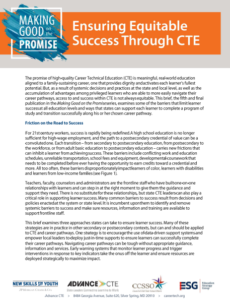 Financial expenses, work commitments, developmental education and healthcare needs are some of the most common barriers to success for community college students, according to a
Financial expenses, work commitments, developmental education and healthcare needs are some of the most common barriers to success for community college students, according to a  Eric sees his new role as an opportunity to update New Hampshire’s CTE system and make changes that will have lasting impacts. To accomplish this, Eric has been everything but a stranger to innovative ideas.
Eric sees his new role as an opportunity to update New Hampshire’s CTE system and make changes that will have lasting impacts. To accomplish this, Eric has been everything but a stranger to innovative ideas.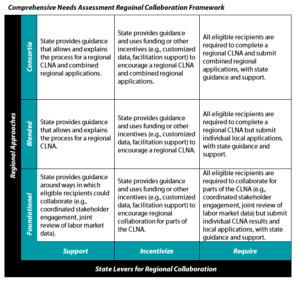
 The CCRC research points out that noncredit programs are also increasing in popularity,
The CCRC research points out that noncredit programs are also increasing in popularity,  It is common practice in the private sector to use big data to improve efficiency, strengthen product quality and better target services to customers. Can data also be used to improve the quality of public education, specifically Career Technical Education (CTE)?
It is common practice in the private sector to use big data to improve efficiency, strengthen product quality and better target services to customers. Can data also be used to improve the quality of public education, specifically Career Technical Education (CTE)?
 One of the most significant and exciting changes introduced in the Strengthening Career and Technical Education for the 21st Century Act (Perkins V) is the new comprehensive local needs assessment (CLNA). The purpose of the CLNA is to support data-driven decisionmaking and more closely align planning, spending and accountability activities under Perkins V. The results of the local needs assessment must form the foundation of the local application and drive local spending decisions.
One of the most significant and exciting changes introduced in the Strengthening Career and Technical Education for the 21st Century Act (Perkins V) is the new comprehensive local needs assessment (CLNA). The purpose of the CLNA is to support data-driven decisionmaking and more closely align planning, spending and accountability activities under Perkins V. The results of the local needs assessment must form the foundation of the local application and drive local spending decisions.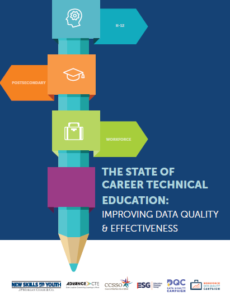 REPORT:
REPORT: 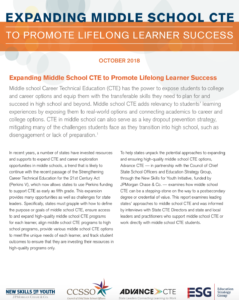 REPORT:
REPORT: 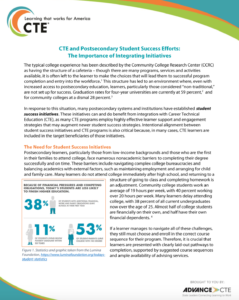 FACT SHEET:
FACT SHEET: